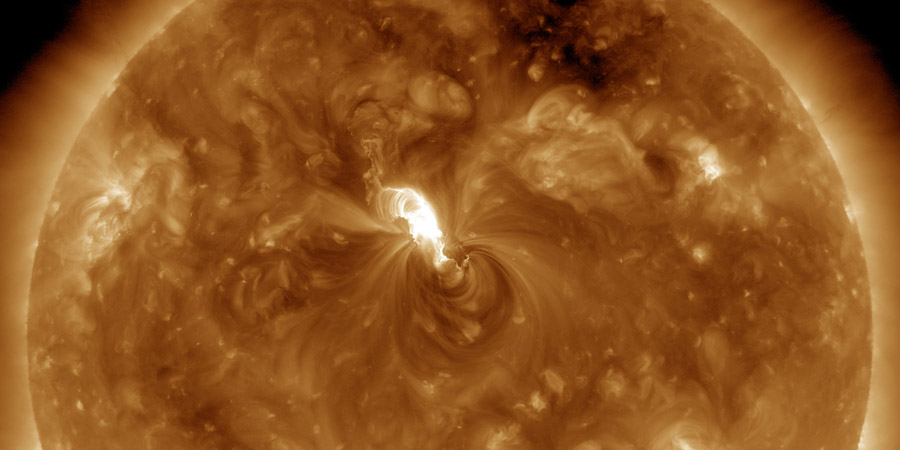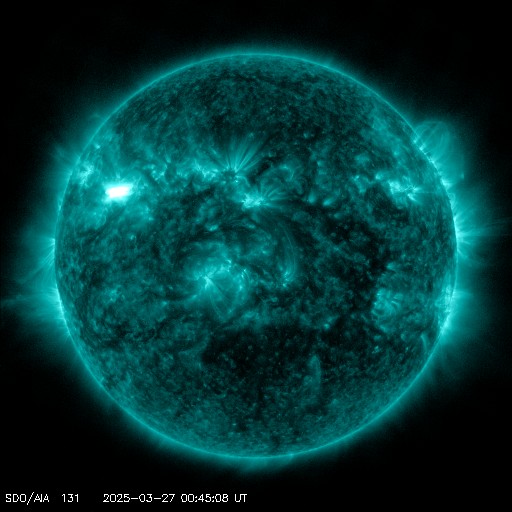M1.7 solar flare with earth-directed CME
Tuesday, 2 November 2021 17:12 UTC

What a week we are having! Hello Solar Cycle 25! Sunspot region 2891 (which is directly facing Earth!) produced a very long duration M1.7 (R1-minor) solar flare this morning that peaked at 03:01 UTC.
This solar flare was eruptive and this sunspot region was in a perfect Earth-facing position to launch a coronal mass ejection towards Earth which it did. We get it, we are all still traumatized from the disappointing coronal mass ejection arrival from the X1.0 solar flare. But fear not, this coronal mass ejection is much better aimed towards Earth. Looking at SOHO LASCO (see the tweets below) we see a very nice asymmetrical full halo coronal mass ejection. The bulk of the ejecta might have been launched more towards the south and east but still we can not complain to much, this is not going to be a glancing blow. We will notice this impact when the cloud arrives.
The SIDC reports a preliminary speed of about 650km/s for this coronal mass ejection which is not very fast. We do have to keep in mind that the cloud will slow down on its way to Earth so the solar wind speed at Earth will not be that high but the cloud is well aimed at Earth, so a decent impact should still be expected. No worries about a glancing blow for this one!
The SIDC has a preliminary impact time late on Thursday, 4 November with no word yet from the NOAA SWPC on what they predict and what kind of storm conditions to expect. We think a moderate G2 geomagnetic storm watch will be issued for Friday, 5 November and maybe even for late on 4 November based on the trajectory and speed of the plasma cloud but maybe we are getting yet another G3 geomagnetic storm watch. We will see, keep an eye on our social media channel for updates!
Here's an other look at the M1.72 long duration solar flare from a few hours ago. An Earthward directed CME is very likely, we await LASCO imagery to confirm.
— SpaceWeatherLive (@_SpaceWeather_) November 2, 2021
Follow live on https://t.co/4BcFuWLVFL pic.twitter.com/1lvoYX7OIQ
SoHO LASCO C2 coronagraph images show an asymmetric full halo CME with an average speed of about 650 km/s.
— SpaceWeatherLive (@_SpaceWeather_) November 2, 2021
The CME is Earthbound and an arrival can preliminarily be estimated to be in the late hours of November 4, but this will be refined later as forecasts become available. pic.twitter.com/PfFQbmPZsH
What caused the active geomagnetic conditions last night?
We had some nice solar wind/IMF conditions last night and this prompted the question among some people if the activity last night might have been from the X1 solar flare. The answer to that is a clear no. The interplanetary shock at 9:15 UTC on Sunday morning was for sure the coronal mass ejection from the X1 solar flare. The increase in the solar wind conditions last night were due to the leading edge of a coronal hole solar wind stream which came from the northern hemisphere polar coronal hole. We see today the high speed solar wind stream following the initial CIR, confirming this is indeed a coronal hole stream. The X1 coronal mass ejection arrived on Sunday and was obviously not so well aimed at Earth as initially thought resulting in lackluster geomagnetic activity compared to what was expected.
Thank you for reading this article! Did you have any trouble with the technical terms used in this article? Our help section is the place to be where you can find in-depth articles, a FAQ and a list with common abbreviations. Still puzzled? Just post on our forum where we will help you the best we can!
Current data suggests there is a slight possibility for aurora to appear at the following high latitude regions in the near future
Gillam, MB, Whitehorse, YT, Yellowknife, NTFairbanks, AK
Latest news
Latest forum messages
Support SpaceWeatherLive.com!
A lot of people come to SpaceWeatherLive to follow the Sun's activity or if there is aurora to be seen, but with more traffic comes higher server costs. Consider a donation if you enjoy SpaceWeatherLive so we can keep the website online!

Latest alerts
06:27 UTC - Hemispheric Power Index
The OVATION model predicts the Hemispheric Power Index to reach 54GW at 07:01 UTC
06:00 UTC - Geomagnetic activity
Minor G1 geomagnetic storm (Kp5) Threshold Reached: 05:51 UTC
00:57 UTC - Solar flare
Moderate M2.05 flare
00:33 UTC - Radio Blackout
Minor R1 radio blackout in progress (≥M1 - current: M1.71)
Wednesday, 26 March 2025
23:00 UTC - Geomagnetic activity
Minor G1 geomagnetic storm (Kp5) Threshold Reached: 22:37 UTC
Space weather facts
| Last X-flare | 2025/02/23 | X2.0 |
| Last M-flare | 2025/03/27 | M2.0 |
| Last geomagnetic storm | 2025/03/26 | Kp6+ (G2) |
| Spotless days | |
|---|---|
| Last spotless day | 2022/06/08 |
| Monthly mean Sunspot Number | |
|---|---|
| February 2025 | 154.6 +17.6 |
| March 2025 | 132.3 -22.3 |
| Last 30 days | 131.2 -21.8 |





